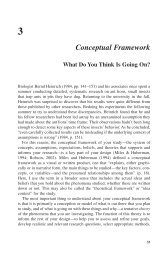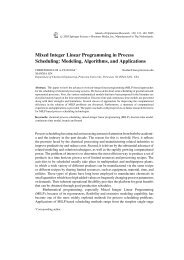Qualitative Research Basics: A Guide for Engineering Educators
Qualitative Research Basics: A Guide for Engineering Educators
Qualitative Research Basics: A Guide for Engineering Educators
You also want an ePaper? Increase the reach of your titles
YUMPU automatically turns print PDFs into web optimized ePapers that Google loves.
• Perspective: insider to outsider<br />
• Who conducts the inquiry: professionals to people in the setting being studied<br />
• Disclosure of the observer’s role: full disclosure to no disclosure<br />
• Duration of observations: short, single observation to long-term, multiple<br />
observations<br />
• Focus: single element to holistic view of the setting<br />
Conducting an Observational Study<br />
Prior to conducting an observational study, a number of decisions need to be made. As<br />
with any study, the question of whom and what will be observed is paramount, and must<br />
be consistent with the epistemological perspective and research questions. If one is<br />
approaching the research from a constructivist perspective, observations of groups would<br />
not be appropriate.<br />
For a structured study, the specific data to be collected must be identified ahead of time.<br />
In an unstructured study, the process evolves as data collection proceeds. This process<br />
has been described as a “funnel” (Punch, 1998). Initially there are only broad questions<br />
that the researcher wants to answer. As observation proceeds and data are collected, the<br />
research questions are refined in light of the data collected, and the focus of the<br />
observations becomes tighter in order to narrow in on these revised questions. Punch<br />
(1998) lists five stages of an unstructured observation that were originally suggested by<br />
Silverman (p.186):<br />
• Proposing a set of general questions<br />
• Writing field notes, which are originally broad descriptive categories but which<br />
later are developed into focused categories<br />
• Looking as well as listening<br />
• Testing hypotheses<br />
• Making broader links.<br />
Angrosino (2005) similarly proposes the following levels of specificity that occur during<br />
an unstructured observation study:<br />
• Descriptive observation: All details are recorded.<br />
• Focused observation: Only those activities that are relevant are recorded.<br />
• Selective observation: Specific elements of the general activities are recorded.<br />
With any observational study, particularly one that occurs in a naturalistic setting, the<br />
question of gaining access is paramount. Often this involves identifying “gatekeepers,”<br />
key people who can provide access. Gaining the trust of those being observed is very<br />
important in order to gain a true picture of the setting, which is why observational studies<br />
can take a long time to conduct. Another important aspect of observation is identifying a<br />
“key in<strong>for</strong>mant.” This is a person who is particularly knowledgeable, insightful, or<br />
articulate and acts as a primary resource to access others.<br />
Collection of data can be done in many ways. In structured observation, a checklist will<br />
often suffice. In unstructured observation there needs to be some way to record the<br />
30
















